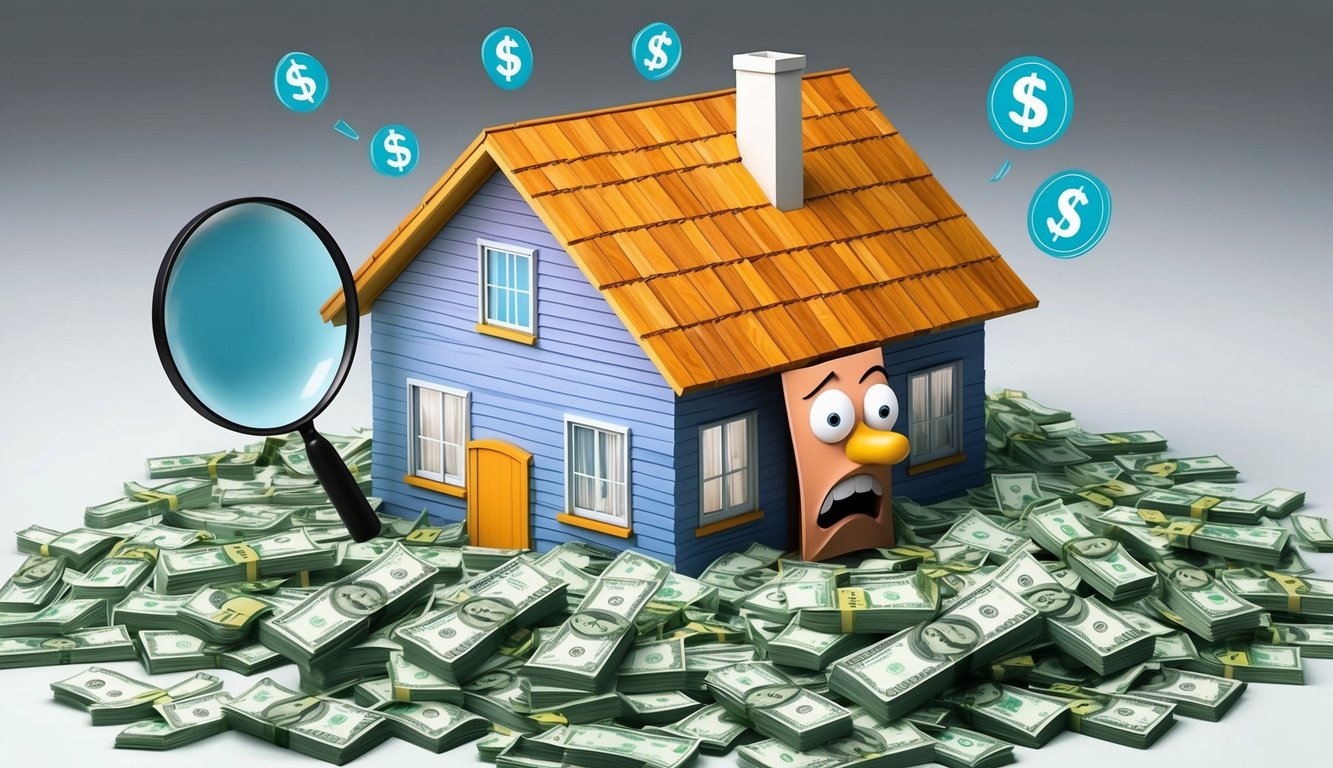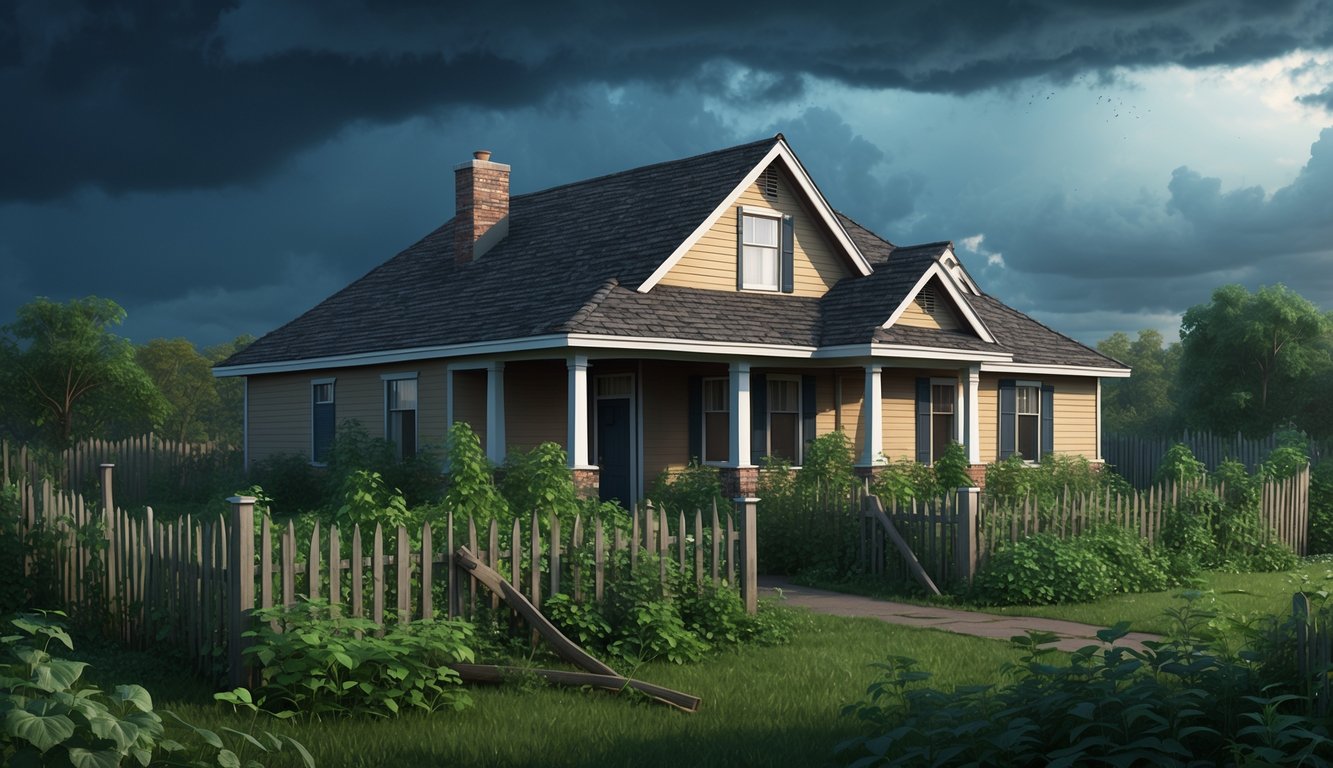Home insurance is a crucial safeguard for protecting your most valuable asset.
However, many homeowners unknowingly pay more than necessary for their coverage.
Understanding the signs of overpaying can help you make informed decisions and potentially save money on your premiums.
By identifying key indicators that you might be paying too much for home insurance, you can take steps to optimize your coverage and reduce costs. This article will explore seven common signs that suggest you may be overpaying for your home insurance policy.
Being aware of these factors can empower you to make adjustments and ensure you’re getting the best value for your insurance dollar.
1) Unexplained Rate Increases
Your home insurance premium shouldn’t mysteriously skyrocket without reason.
If you notice a significant increase in your rates, it’s time to investigate.
Insurance companies typically provide explanations for rate hikes.
These could include changes in risk factors or adjustments to coverage.
When your insurer fails to justify a substantial increase, it’s a red flag.
You might be paying more than necessary for your coverage.
Keep an eye on your renewal notices.
Compare them to previous years’ premiums.
A jump of more than 10% without explanation warrants further inquiry.
Contact your insurance agent or company representative.
Ask for a detailed breakdown of the rate increase.
If they can’t provide satisfactory answers, consider shopping around.
Remember, inflation and natural disasters can impact insurance costs industry-wide.
However, your individual rate shouldn’t change dramatically without specific reasons related to your property or coverage.
Don’t hesitate to compare quotes from other insurers.
You might find better rates elsewhere for similar coverage.
2) Coverage You Don’t Need

Reviewing your home insurance policy can reveal coverage options you may not require.
Eliminating unnecessary coverage can lower your home insurance costs significantly.
For instance, if you don’t own valuable jewelry or artwork, you might not need additional personal property coverage.
Standard policies often provide adequate protection for typical household items.
Flood insurance might be unnecessary if you live in a low-risk area.
Check your home’s flood zone designation before deciding on this coverage.
Earthquake insurance can be skipped if you’re not in a seismically active region.
Consider your location and the likelihood of such events.
If you’ve paid off your mortgage, you’re no longer required to carry mortgage insurance.
Removing this coverage can reduce your premiums.
Umbrella policies provide extra liability protection, but you may not need one if you don’t have significant assets to protect.
Reassess your coverage amounts periodically.
If you’ve downsized your possessions, you might be able to reduce your personal property coverage.
Remember, while it’s important to have adequate protection, paying for unnecessary coverage doesn’t make financial sense.
Review your policy annually and adjust it based on your current needs and circumstances.
3) High Deductibles
High deductibles on your home insurance policy could be a sign you’re paying too much.
While higher deductibles typically come with lower premiums, they also mean you’ll have to pay more out-of-pocket when you file a claim.
If you’ve chosen a high deductible to reduce your monthly costs, you might be overcompensating.
It’s important to strike a balance between affordable premiums and a deductible you can comfortably manage in case of an emergency.
Consider your financial situation carefully.
If you have enough savings to cover a higher deductible, it might make sense.
However, if paying a $5,000 deductible would strain your finances, you may want to reconsider your policy.
Remember, deductibles for home insurance policies usually range from $500 to $5,000.
Evaluate your options and choose a deductible that aligns with your budget and risk tolerance.
Keep in mind that extremely high deductibles might deter you from filing legitimate claims.
This could lead to you not using the insurance you’re paying for, essentially wasting money on premiums.
Review your policy regularly.
If your financial situation has improved, you might be able to lower your deductible without significantly increasing your premiums, potentially saving money in the long run.
4) Low Claim Limits
Your home insurance policy may have claim limits that are too low for your needs.
These limits cap the amount the insurer will pay for specific types of claims.
Check your policy’s limits for personal property, liability, and additional living expenses.
If they seem inadequate, you might be paying too much for insufficient coverage.
For example, if your personal property limit is $50,000 but you own $100,000 worth of belongings, you’re underinsured.
You’d be paying for coverage that won’t fully protect you in case of a major loss.
Similarly, low liability limits can leave you financially exposed if someone is injured on your property.
Consider whether your current limits would cover potential legal fees and damages.
Additional living expenses coverage helps pay for temporary housing if your home becomes uninhabitable.
Ensure this limit is enough to cover realistic costs in your area.
Review your policy’s sublimits as well.
These are lower limits for specific items like jewelry or electronics.
If these sublimits are too low, you may need to increase them or purchase additional coverage.
By addressing low claim limits, you can ensure you’re getting appropriate coverage for your premium.
This helps you avoid overpaying for inadequate protection.
5) Lack of Discounts

Insurance companies offer various discounts that can significantly reduce your home insurance premiums.
If you’re not taking advantage of these, you might be paying too much.
Many insurers provide discounts for installing security systems or safety features in your home.
These can include burglar alarms, smoke detectors, and deadbolt locks.
You may also qualify for discounts if you bundle your home and auto insurance with the same company.
This can lead to substantial savings on both policies.
Some insurers offer loyalty discounts for long-term customers.
If you’ve been with your insurance company for several years and haven’t seen a reduction in your premiums, it’s worth inquiring about this.
Improving your home’s resilience against natural disasters can also lead to discounts.
For instance, installing an impact-resistant roof can earn you a significant discount in some states.
Don’t forget about lifestyle-based discounts.
If you’re a non-smoker or retiree, you might be eligible for lower rates.
It’s important to regularly review your policy and ask your insurer about all available discounts.
If your current provider isn’t offering competitive discounts, it might be time to shop around for a new policy.
6) Unclear Policy Terms
Insurance policies can be complex documents filled with industry jargon.
If you find yourself struggling to understand the terms and conditions of your home insurance policy, it might be a sign you’re paying too much.
Unclear policy terms can lead to confusion about what’s covered and what’s not.
This lack of clarity may result in you purchasing unnecessary additional coverage or failing to take advantage of discounts you’re eligible for.
Take the time to carefully review your policy.
If you encounter terms or clauses you don’t understand, reach out to your insurance agent or company for clarification.
They should be able to explain your coverage in simple, easy-to-understand language.
Paying for unnecessary home insurance costs doesn’t make sense.
If you’re unsure about certain aspects of your policy, it’s worth getting a second opinion or comparing quotes from other insurers.
Consider asking for a detailed breakdown of your coverage and premiums.
This can help you identify areas where you might be overinsured or paying for coverage you don’t need.
7) No Loyalty Rewards

Many homeowners stay with the same insurance company for years, assuming their loyalty will be rewarded.
Unfortunately, this isn’t always the case.
If you’ve been with your insurer for a long time and haven’t seen any loyalty discounts or benefits, you might be paying too much.
Insurance companies often offer their best rates to new customers to attract business.
This means long-term policyholders can end up paying higher premiums than new clients for the same coverage.
Loyalty isn’t always rewarded in the insurance industry.
Some companies may offer small perks like accident forgiveness or vanishing deductibles, but these might not offset the potential savings from switching providers.
It’s important to regularly compare your current policy with offers from other insurers.
You might find that you can get the same or better coverage at a lower price.
Don’t assume that bundling your home and auto insurance with one company always results in the best deal.
While it can often lead to discounts, it’s not guaranteed to be the cheapest option.
If you’ve been with your insurer for several years without seeing any meaningful loyalty rewards or decreasing premiums, it’s time to shop around.
You might be surprised by how much you can save by switching providers.
Remember, your insurance company is a business, and their primary goal is to make money.
It’s up to you to ensure you’re getting the best value for your premiums.
The Fundamentals of Home Insurance

Home insurance protects your property and finances.
It covers damages to your house and belongings while providing liability protection.
Understanding Premiums
Your home insurance premium is the amount you pay for coverage.
Several factors affect this cost:
- Location: Areas prone to natural disasters or high crime rates typically have higher premiums.
- Home value: More expensive homes cost more to insure.
- Construction type: Frame houses often have higher premiums than brick homes.
- Age of home: Older homes may have higher premiums due to outdated systems.
Your credit score can also impact your premium.
Many insurers offer lower rates to those with good credit.
Policy Coverage Basics
Standard home insurance policies typically include:
- Dwelling coverage: Protects the structure of your home.
- Personal property coverage: Insures your belongings.
- Liability protection: Covers legal expenses if someone is injured on your property.
- Additional living expenses: Pays for temporary housing if your home becomes uninhabitable.
It’s crucial to understand your policy limits and deductibles.
Higher deductibles can lower your premium by up to 25%.
Review your policy annually to ensure you have adequate coverage without paying for unnecessary extras.
Common Factors That Influence Insurance Costs

Your home insurance premium is determined by various elements that insurers consider when assessing risk.
Understanding these factors can help you identify potential areas where you might be overpaying.
Location and Risk Factors
Your home’s location plays a crucial role in determining insurance costs.
Homes in areas prone to natural disasters like hurricanes, tornadoes, or wildfires often face higher premiums.
The crime rate in your neighborhood also impacts your rates.
If you live in an area with high theft or vandalism rates, expect to pay more.
Proximity to fire stations and hydrants can affect your costs too.
Homes closer to these facilities may receive lower rates due to faster emergency response times.
Your home’s construction type matters as well.
Brick homes are often cheaper to insure than wood-frame houses due to their fire resistance.
Home Value and Replacement Cost
The cost to rebuild your home significantly influences your insurance premium.
This isn’t necessarily the market value of your home, but rather the expense to reconstruct it from the ground up.
Factors affecting replacement cost include:
- Square footage
- Construction materials
- Special features (custom woodwork, high-end appliances)
- Local building costs
If you’ve recently renovated or upgraded your home, inform your insurer.
While improvements might increase your premium, they ensure you’re adequately covered.
Your personal property coverage, typically a percentage of your dwelling coverage, also affects your premium.
Expensive items like jewelry or art may require additional coverage.
Strategies to Lower Home Insurance Premiums

You can take several actions to reduce your home insurance costs.
These strategies focus on making your home safer and leveraging policy options to your advantage.
Bundling Policies
Combining multiple insurance policies with the same company can lead to significant savings.
Consider bundling your home and auto insurance for discounts of up to 25%.
Many insurers offer multi-policy discounts for combining home, auto, life, or other types of coverage.
This approach not only saves money but also simplifies your insurance management.
Ask your current provider about bundling options.
If they don’t offer competitive rates, shop around for companies that specialize in multi-policy discounts.
Remember to compare the total cost of bundled policies against separate policies from different insurers.
Sometimes, individual policies from various companies might still be cheaper.
Improving Home Security
Enhancing your home’s security can lead to lower premiums and better protection.
Many insurers offer discounts for safety features that reduce the risk of theft or damage.
You can potentially save up to 20% on your premiums by installing a monitored security system.
These systems alert authorities in case of break-ins or fires.
Other security improvements to consider include:
- Deadbolt locks on all exterior doors
- Smoke detectors and fire alarms
- Carbon monoxide detectors
- Water leak detection systems
Don’t forget to inform your insurance provider about any security upgrades.
They may require proof of installation or regular maintenance to apply the discount.
Consider smart home devices that can detect issues early.
Water sensors, smart thermostats, and connected smoke alarms can prevent costly damage and may qualify for additional discounts.






